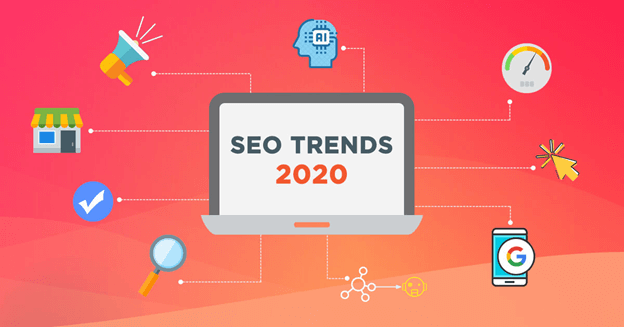SEO trends that ruled the year 2020

Each year, hundreds of changes happen in Google's Search Algorithm. With new websites and businesses towering in the Digital World, the need to make SEO ranking criteria more precise increases. Since 2019, there have been four to five significant changes in Google's Search Algorithm, including two core updates, one Site Diversity Update – Maverick, and the BERT update.
As more and more readers are pouring their time to surf, find, read, connect, and buy online, your website must be optimized and engaging enough for your audience.
SEO is pretty dynamic; things change fast. To keep up, you need to ensure that your websites adapt to the new trends and follow the disciplines. Certain things would remain the same, like meta tags, meta descriptions, long-tail keywords, optimizing images with alt tags, backlinks, and quality content.
You need to be a visionary if you want to sustain it for a long time.
This year, there were some SEO trends that experts talked about, and learners implemented to enjoy its long-term benefits.
Here's a rundown to some of the top SEO trends that have and will rule the Digital world.
1. User Experience
Be it any client; the need to create wooing websites, the one with a great user experience comes first.
There was a post on Google Webmaster in May, which talked about how your website's User Experience will play a vital role in Search Engine Rankings. What does this mean? It means SERPs are going to be more user-oriented. The people. UX is going to lead the game of Search Engine's ranking factors. Even Google is prioritizing intuitive human experiences over other things.
Statistics say that user behaviors are changing – they prefer to spend more time engaging with a website that delegates an excellent User Experience. Google's Core Web Vitals is one such update that talks about website essentials. It includes three parameters:
- LCD (Largest Contentful Paint) – Measures the loading time of your website.
- FID (First Input Delay) – Measures how interactive your website is for the user.
- CLS (Cumulative Layout Shift) – Measures the visual stability of your website.
Imagine landing on a webpage that takes a billion-years to open. Irritating, isn't it? Google wants to make sure that users have delightful web experience. If your website has the potential to maintain these scores, it is undoubtedly going to hit the roof in terms of search engine rankings.
The better they are, the higher are the chances for you to rank better in Search Engines.
Thanks to Google Search Console, you can now check your website's health through the Core Web Vitals report. It scans your website from a UX perspective and suggests the required changes.
2. SERPs are becoming holistic
Search Engine Result Pages (SERPs) have been changing its course of action. Unlike those old times, the SERPs have become more inclusive where featured snippets, google answers, display ads, “People Also Ask” have stolen the thunder. Searches have become more personalized, comfortable, and accessible.
The featured snippets are given the highest priority by Google, displaying the relevant answers to search queries above both paid ads and organic rankings. Ahrefs conducted a study on 2 million featured snippets, and the results were pretty surprising. It revealed that these snippets receive more traffic than the top 3 organic search results.
Question-based search queries end up getting more clicks, conversions, and higher rankings comparatively. Do some homework and try including the questions from “People Also Ask” in your web pages to rank faster and receive relevant clicks.
3. Influencer Marketing for SEO

Digital Marketers and business feel and believe that Influencer Marketing is going to be the A-game. No wonder why 17% of companies spend more than half of their total marketing budget on influencers. Reasons are apparent – influencers enjoy a niche-based market, trust-factor, and reach.
These statistics hold for businesses belonging to every domain, including fashion, eCommerce, FMCG, Sports, Health and Fitness, Travel, Lifestyle, and digital marketing.
Online users are influenced by ads and promotions, especially if it comes from a trustworthy source. Say, if you are one of those 239 million Instagram followers of Cristiano Ronaldo – the reviews and recommendations coming from his end will always be overwhelming for his followers. It may be a training gear, a hair care product, or even Nike's struts – Mercurial for football lovers.
Users tend to trust influencers more than just standard ads. The game of influencer marketing is based on one fundamental – who is saying it, rather than what are they selling.
Connecting with some influencers and spending a share of your marketing budget on them will help you receive more reach, footfalls, higher brand visibility, and trust. The link juice that you gain by such collaborations results in building brand authority in the eyes of Search Engines because even search engines trust these influential identities and their words.
Numerous companies have failed or think otherwise – that it doesn't reap good ROIs. Any marketing campaign would fail if you didn't do groundwork properly (finding a target audience, understanding the competition, collaborating with the right influencers), and aligning them with your business objectives.
4. Leveraging BERT for long-term results

Google's BERT (Bidirectional Encoder Representations from Transformers) is considered one of the significant algorithm updates they have made in recent times. The algorithm was designed to automate the structure of search queries users fire. Not every user knows how to frame a question to get the most relevant results. Google's BERT targets this problem – to formulate billions of search queries understandable by the Search Engines.
The underlying aim of Google is simple – Search is about understanding the language. SEO marketers over the world have taken this update to be a significant one, as the results were pretty amazing. The BERT model worked great for the featured snippets and witnessed an increase in Google's search rankings.
BERT took care of the conversational queries by considering the prepositions (to, for, on, etc.) to be vital in understanding user's search queries. It refined the user intent – the only thing that lies at every marketing campaign's heart.
A user intent for his/her search query can fall under any of these three categories – informational, transactional, or navigational. So, before you pen down the content for your landing pages, PPC pages, websites, or even ad copies, make sure you analyze the search engine's top 10 results to understand it. Based on it, you can curate content that intersects user intent and your landing pages.
Conclusion
As a leading WordPress Development Agency and with almost a decade full of learnings and experiences – we are sure about one thing. SEO is here to stay for a really long time. And be it brand building, monetizing your blog or driving business out of your digital portal – SEO is a must. Sticking by the trends and updates will keep you one step ahead of the competition, especially in the ever-evolving Digital World.
839GYLCCC1992




Leave a Reply